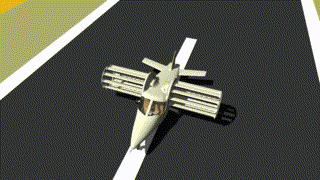

Liftoplane may have some specifics in embarking due to variations in the position of its center of gravity (CG). This can lead to a specific embarking for small-scale vehicles, such as the two-seat aircraft model represented here. The CG position should be aligned with the forward part of the rotors in the embarked state. The undercarriage wheels should be aligned backward from the CG for safe operations on the runway. This alignment exists for this model, but the undercarriage wheels are placed at forward from the axis of the rotors. That means that for an empty aircraft, the CG may be behind of the undercarriage wheels, leading to the fall the aft part of the aircraft on the ground. The represented model has special parking wheels to avoid such a case. When the aircraft is empty, these parking wheels support it, and there is some clearance under the forward wheel. After embarking, this forward wheel supports the aircraft, and there is some clearance under these parking wheels. Before launching, these parking wheels are retracted into the aircraft, and respective hatches close corresponding holes in the fuselage.
The presented liftoplane model has separate entrance doors for the pilot and passenger, which also serve as windows. These doors have pivots on the forward inclined central delimiter of the fuselage, so the doors can be opened up and forward.
The animation below exposes: the entire view of the aircraft on the runway, opening and closing doors, embarking the pilot and passenger with a change in the fuselage pitch, retracting the parking wheels, testing the mobility of the rudder, setting the stabilators and setting the pitches of the wings toward the required PGS-state of the rotors, needed for acceleration on the runway.

Copyright © 2018-2023 Yuri Feldman - All Rights Reserved